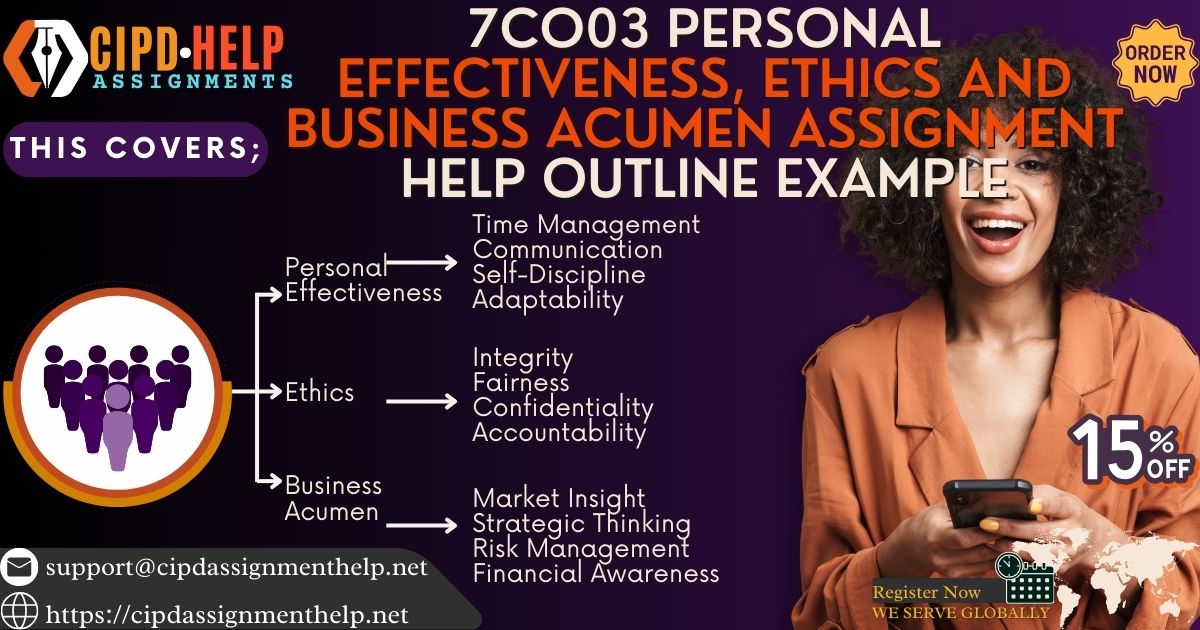7CO03 Personal Effectiveness, Ethics and Business Acumen Assignment Help Outline Example
Task 1: Be able to model principles and values that promote inclusivity aimed at maximising the contribution that people make to organisations.
Critically assess different ethical standpoints on people practice and the maintenance of high standards of ethical behaviour.
Ethical standpoints
- What are ethical standpoints?
- Different ethical standpoints on people practice
- Utilitarianism ethics
- Deontology ethics
- Virtue ethics
-
-
- How do these ethical standpoints guide moral behaviour and decision-making for people practice professionals in the organisation?
- Why are these ethical standpoints important for people practice?
- What are their implications for people practice in the business? For example;
- Analysing moral issues
- What is right or wrong
-
Maintenance of high standards of ethical behaviour for people practice
- Develop a code of ethics in the workplace
- Reinforce the role of the code
- Train all employees
- Reward ethical behaviour
-
- Why is it important to maintain high standards of ethical behaviour for people practice in organisations?
- What are the implications for people practice in maintaining high standards of ethical behaviour for people practice?
Counterargument – What if ethical standpoints and maintenance of high standards of ethical behaviour are not implemented in an organisation? What are the negative impacts for people practice?
Justify business improvements in relation to:
The promotion of fairness and transparency
- Create a positive work environment
- There is trust and loyalty among employees, customers and other stakeholders
- To prevent unethical behaviours in the organisation. For example; nepotism and bribery/kick backs
- They act as an appeal process
Well-being
- Improve productivity
- Enhance overall health of employees
- Increased job satisfaction
- Enhanced employee motivation
Employee voice
- Enhanced communication in the organisation
- Informed decision-making
- Promote innovation and creativity
- Encourage ownership and accountability of workers
Learning
- Increase employee retention
- Enhance employee engagement
- Enhanced adaptability to market changes and new challenges
- Encourage creativity, collaboration and critical thinking for enhanced problem-solving and better decision-making
Self-evaluate personal and professional integrity in relation to ethical practice, professional courage and influence, and valuing people.
Personal integrity
- What does it entail?
- How does personal integrity relate to ethical practice, professional courage and influence, and valuing people?
- Self-evaluation
-
- How can I describe my personal integrity?
- How do I practice personal integrity in promotion of ethical practice?
- How does my personal integrity enhance my professional courage and influence?
- What personal integrity actions or behaviours do I practice to demonstrate valuing people?
Professional integrity
- What does it entail?
- How does professional integrity relate to ethical practice, professional courage and influence, and valuing people?
- Self-evaluation
- How can I describe my professional integrity?
- How do I practice professional integrity in promotion of ethical practice?
- How does my professional integrity enhance my professional courage and influence?
- What professional integrity actions or behaviours do I practice to demonstrate valuing people?
- Why is personal and professional integrity self-evaluation important for me as a people practice?
- What are the implications for other people practice in organisations?
Assess the impact of collaboration across cultural, geographic and professional boundaries, including the value of embracing difference.
- Collaboration
- What does it entail in an organisation?
- How does it happen across cultural, geographic and professional boundaries?
- How does collaboration promote the value of embracing difference?
- What are the impacts of collaboration across;
- Cultural boundaries
- Geographic boundaries
- Professional boundaries
- What are the impacts of collaboration on the value of embracing difference?
Task 2: Be able to achieve and maintain challenging business outcomes for yourself and organisations.
Reflect on levels of self-awareness, self-management and continuous self-improvement, leading to improved organisational success and career progression.
Levels of self-awareness
- Internal vs. external awareness
- Private vs. public awareness
- Differentiation
- How do these levels lead to improved organisational success and career progression?
- Use personal experiences to demonstrate, reflect and explain the answer.
Levels of self-management
- Time management
- Stress management
- Accountability
- How do these levels lead to improved success and career progression?
- Use personal experiences to demonstrate, reflect and explain the answer.
Levels of continuous self-improvement
- Building relationships
- Practicing mindfulness
- Building confidence
- How do these levels lead to improved success and career progression?
- Use personal experiences to demonstrate, reflect and explain the answer.
Discuss how business acumen can deliver commercial benefits and manage resilience.
- Give a brief description of business acumen?
- Give a brief description of commercial benefits?
- Give a brief description of resilience
- How does business acumen deliver commercial benefits and manage resilience?
- Commercial benefits: by
- Minimising risk in the organisational activities
- Embracing innovation for greater efficiency and productivity in the organisation
- iii. Win the markets through greater focus on customers
- Identify growth and development opportunities
- Manage resilience
- Building of mutual relationships with suppliers and clients
- Strategic thinking for navigating complex business environment
- Adaptability to navigate through uncertain times
- View situations in different perspectives
- Commercial benefits: by
- What are the implications for people practice professionals in an organisation when promoting commercial benefits and managing resilience?
- Counterargument – What if business acumen is not considered in the promotion of commercial benefits and managing of resilience? What are the negative effects to the organisation?
Demonstrate impactful behaviour that is aligned with wider organisational vision, values, strategies and plans.
- What is an impactful behaviour in an organisation?
- Impactful behaviour that is aligned with wider organisational vision, values, strategies and plans
- Clear communication
- How is clear communication aligned with wider organisational vision, values, strategies and plans?
- How do I demonstrate clear communication to align with wider organisational vision, values, strategies and plans?
- Communicate the organisational vision, values, strategies and plans to employees
- Consistent reminder of these organisational vision, values, strategies and plans to employees
- Stating the vision, values, strategies and plans to employees
- Explaining them to workers and how they relate to strategic priorities, objectives and expectations of the business
- Explaining how the employee goals contribute to the achievement of the organisational vision, strategies, values and plans
- Provide feedback of employee progress, and recognition of their efforts on performance
- Maintaining transparent, inclusive and frequent communication
- Using different channels and formats of communication. For example; social media, newsletters, meetings and intranet.
- Clear communication
Assignment Activity 3: Be able to apply learning to enhance personal effectiveness.
Demonstrate curiosity and passion for deep learning.
- What is deep learning for people practice?
- What does it entail?
- Why is it important for people practice professionals?
- As a people practice professional, how do I demonstrate curiosity and passion for deep learning?
- I have a shifted focus on self-driven learning by;
- Using feedback from employees to improve
- Having a willingness to take risks
- Having great interest in and practice of innovative learning culture
- Challenging myself with new tasks and gaining of new skills
- I have a shifted focus on self-driven learning by;
- Why is it important for me to have curiosity and passion for deep learning?
- Counterargument – What is the negative impact to me if I fail to demonstrate curiosity and passion for deep learning?
Plan continuing professional development that involves both planned learning and reflection.
- Continuing Professional Development Plan
- What does it entail?
- For people practice, why is continuing professional development important?
- The plan;
- Planned learning – Use a table to present the planned learning and include the following;
- What am I planning to learn?
- What is the time frame?
- What activities will involve?
- What are the outcomes?
- Reflection
- What were the knowledge gaps?
- What actions did I take to modify actions and behaviours?
- Will my objectives of learning be met?
- Do the activities apply to the current people practice?
- What challenges will I experience during the learning?
- What areas do I need to improve in future, or further learning areas?
- What activities will I need to focus on in the next set timeframe? For example, in the next 12 months.
- Planned learning – Use a table to present the planned learning and include the following;
Discuss the merits of evidence-based critical thinking based upon a range of data analytics, across a wide range of current business topics.
- What is evidence-based critical thinking?
- What is data analytics?
- Examples/a range of data analytics
- Data visualisation analytics – example; graphs, and charts
- Descriptive analytics – example use of statistics and data mining to analyse patterns and behaviours on historical data
- Regression analysis – analyse the relationship between independent and depended variable(s)
- What evidence-based critical thinking applies in a range of data analytics?
- The cause of change, trend,
- Answer the why question
- Apply outside knowledge
- Apply own experience
- Find applicability of the data in people practice
- Is the data rich or poor
Assess the impact that sharing of learning has on organisational success.
- What does sharing of learning entail?
- Describe organisational success
- Assessing the impact that sharing of learning has on organisational success
- Improved performance at individual and organisational level
- Foster positive relationships among staff
- Prepare employees for change, navigate change and drive growth
- Build a collective knowledge for streamlined processes and better guidelines
- What are the implications for people practice to share learning in an organisation?
- Counterargument – What if they fail to share learning in an organisation? What will happen or what is the negative eimpact to the organisation and its success.
Learning Outcome 4: Be able to influence others during decision-making while showing courage and conviction.
Assess own approaches to decision-making on complex issues, taking ownership to remedy mistakes.
- Own approaches to decision-making on complex issues
- Rational decision-making
- Problem definition
- Identify possible solutions – use a selected criteria suitable for your your objectives
- Assess each criterion and their importance
- Generate a list of possible alternatives
- Evaluate alternatives based on their importance to providing a solution
- Determine the best solution
- Advantages and disadvantages of this approach
- Intuitive decision-making
- Light fast pattern recognition
- Review everything I have learned from past situations that are similar to the current situation
- Consider additional options
- Advantages and disadvantages of this approach
- Rational decision-making
- Taking ownership to remedy mistakes
- I take ownership to remedy mistakes by;
- Acknowledging and admitting my mistake
- Seeking forgiveness
- Making amends
- Accepting the consequences
- The importance of owning and remedying my mistakes in the workplace
- A demonstration of professionalism
- It is part of personal growth
- It promotes self-awareness
- I am more accountable and willing to learn from my mistakes
- Enhances my resilience and professional success
- I take ownership to remedy mistakes by;
Demonstrate appropriate influencing style to communicate and engage different audiences.
- Appropriate influencing style to communicate and engage different audiences
- Rationalising
- What does it involve? For example;
- Use of logic and reasoning to persuade others
- How and when do I use this influencing style. Give a scenario or a situation that requires influence to demonstrate the answer
- Why I think this style is suitable for me
- I am analytical
- I often use facts and data to support points of view
- Evaluation – Has the style been effective?
- What does it involve? For example;
- Rationalising
Discuss ways of promoting organisational improvement through courage, political acumen and the willingness to challenge.
- Ways of promoting organisational improvement through;
- Courage
- Have a willingness to be brave
- Challenge people and practices
- Political acumen
- Use leaders as role models
- Be a good example by doing the right thing
- Meet moral and legal duties
- Willingness to challenge
- View failure as a chance or opportunity to improve learning
- Emphasise on using good judgement
- Use evidence to support action
- Choose the appropriate language depending on the context
- Courage
- To what extend are these ways effective in promoting organisational improvement?
- What are the implications for people practice professionals?
Assess the benefits of networking to enhance own career and contribution to organisational effectiveness.
- The benefits of networking to;
- Enhance own career – beneficial through
- Participating in clubs – for example wellbeing and after work clubs
- Engage in linkedIn learning
- Social networking to build relationships
- Contribution to organisational effectiveness – beneficial through
- Benchmark personal and organisational goals
- Career development opportunities in the organisation for greater success
- Enhance own career – beneficial through





